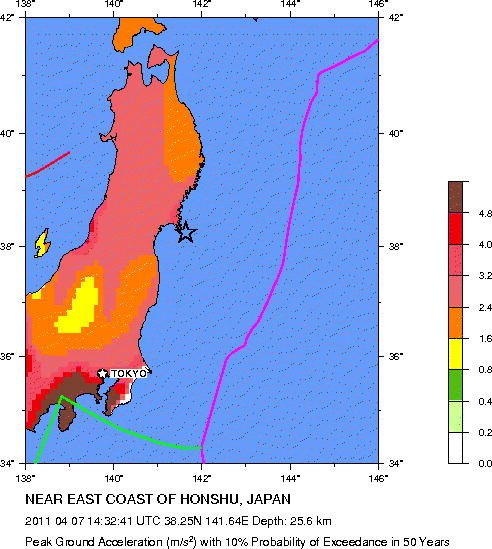TOKYO, April 7 (UPI) -- A strong earthquake struck off the coast of Japan Thursday, prompting officials to issue a tsunami warning for one prefecture and advisories for others.
The Japan Meteorological Agency said the quake registered 7.4-magnitude. The U.S. Geological Survey initially reported the quake at 7.4-magnitude but revised it to 7.1-magnitude.
The Pacific Tsunami Warning Center later canceled the tsunami warnings and advisories.
No reports of casualties from anywhere in the earthquake zone have been reported.
Workers evacuated the Fukushima Daiichi nuclear plant following the quake, said Tokyo Electric Power Co., the facility's operator. The company said there were no immediate reports of damage.
The quake's epicenter was off the coast of Miyagi in northeastern Japan, the Japan Meteorological Agency said.
The USGS said the quake was 41 miles from Sendai, one of the worst-hit areas in the March 11, 9-magnitude earthquake, 73 miles from Fukushima where a crisis has been under way at the nuclear plant since.
Meanwhile, nitrogen was pumped Thursday into a reactor container at Japan's crippled Fukushima nuclear plant to avert risk of explosion.
Workers of Tokyo Electric Power, which operates the six-reactor plant, hit by the March 11 earthquake and tsunami, began the nitrogen injection into the No. 1 reactor. It comes a day after workers stopped the leakage of high-level radioactive water from a cracked pit near the No. 2 reactor into the Pacific Ocean, an issue that has raised concerns about seafood contamination.
Commenting on the latest process, the government's nuclear safety agency spokesman Hidehiko Nishiyama stressed that the nitrogen injection is only a "preventive measure," and there is no "immediate danger" of any explosion, Kyodo News reported.
A March 26 confidential assessment document by the U.S. Nuclear Regulatory Commission, obtained by The New York Times, had noted the Fukushima plant could face new threats, one of which being explosions inside the containment structures as seawater pumped into them can release hydrogen and oxygen.
The NRC document, based on input from U.S. engineers sent to Japan to help with the crisis, had suggested injecting nitrogen into the containment structures to dissipate any hydrogen and oxygen buildup.
The nitrogen injection work was expected to continue for a few days. Similar injections could also take place at the No. 2 and 3 reactors.
Among other challenges, Tokyo Electric workers also must remove the contaminated water from within the plant.
The leakage into the Pacific Ocean was stopped Wednesday with the use of huge quantities of various chemical agents including sodium silicate or "water glass." Nishiyama said no further leakage has been noticed from the pit, Kyodo said.
However, it was not known if the leakage could resume from other areas. The No. 2 reactor's core partially melted with the loss of its cooling function caused by the quake and tsunami, and forced the radioactive water into the pit.
The contaminated water is also standing in the way of restoration work. That is forcing the utility to dump into the sea low-level contaminated water from a nuclear waste disposal facility so as to make more storage room for the high-level contaminated water flooding the turbine buildings.
About 10,000 tons of the low-level radioactive water still remains to be dumped by this weekend.
Despite the government's assurances there are no health risks from the steps taken so far, they have raised serious concerns in other countries and strong protests from Japan's hard-hit fishing industry.
The irate fishermen say Tokyo Electric's measures are insulting, incompetent and "unforgivable," CNN reported.
The National Fishery Corporative Joint Association said the utility and the Japanese government must "compensate all parties (that have) indirectly or directly suffered" because of the nuclear crisis," adding those "who are living and sustaining their lives on the sea are feeling strong rage against (the utility and the government's) irresponsible behavior."
Japan's Chief Cabinet Secretary Yukio Edano apologized Wednesday for the way the government had communicated the need to dump the radioactive water from the plant.
The escape of the radioactive water may have contaminated sea marine environment near the plant as the latest seawater sample taken from near the plant far higher levels of radioactive Iodine-131 than the legal limits. Additionally, radioactive cesium over the legal limit was found in young launce or sand eel, in waters near the northern part of Ibaraki prefecture, north of the Fukushima prefecture.
The March 11 disaster knocked out the plant's power grid and most of the emergency diesel generators, which in turn resulted in the loss of many of the reactors' key cooling functions, partial melting of reactor cores and hydrogen explosions.
Kyodo quoted a Tokyo Electric estimate that 25 percent of the nuclear fuel rods have been damaged at the No. 3 reactor. An earlier estimate said 70 percent of the No. 1 reactor's fuel rods and 30 percent of the No. 2 reactor's fuel rods had been damaged.
Any new threat of explosions could come from radiation-induced separation of water into hydrogen and oxygen.
In other developments, The Japanese government planned to cut the foreign aid allocation for this fiscal year by 20 percent to finance the additional budget for quake-tsunami relief and reconstruction, Kyodo reported, quoting sources in the government and the ruling Democratic Party of Japan-led coalition.
The report said the cuts will be made from the 570 billion yen or $6.6 billion official development assistance program.
The government also was reviewing radiation exposure levels used to designate the evacuation zone around nuclear power plant.
The government also may allow residents of areas within the zone to return home for short, supervised visits.















